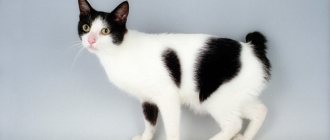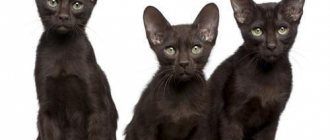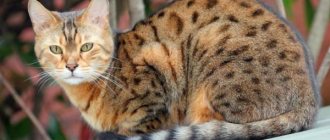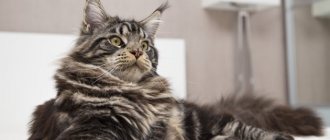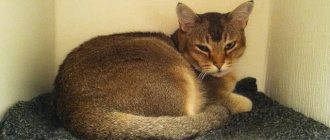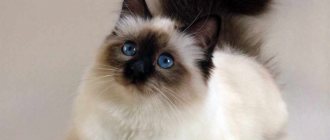History of the Mekong Bobtail breed
The homeland of the Mekong Bobtail is Southeast Asia.
The breed was named after the Mekong River, which flows through Thailand, Myanmar, Cambodia, Laos, and Vietnam. The word "bobtail" refers to the presence of a short tail. Initially, cats were called Siamese, then Thai, and only in 2003 they were called Mekong to avoid confusion with other breeds. One of the first descriptions of these cats belonged to Charles Darwin, who mentioned them in 1883 in his work “Changes in Domestic Animals and Cultivated Plants.” At home, the breed was considered royal. Thai bobtails lived on the territory of temples and palaces. For a long time, to protect the breed, the Thais prohibited the export of cats. Mekong Bobtails left the country extremely rarely and only as especially valuable gifts. Recipients included Nicholas II, British Ambassador Owen Gould and Anna Crawford, governess to the children of the Siamese king. The breed came to Europe in 1884, and to America in the 1890s.
There was a legend that Thai bobtails accompanied their noble owners even in baths - the princesses left rings and bracelets on the curled tails of the cats during bathing procedures. According to other legends, these pets were assigned to guard sacred vases in temples. The effort made the bobtail ponytails curl and the eyes became a little slanted.
For a long time, the breed remained unnoticed, considered a type of Siamese cat. For this reason, breeding for a long time was carried out along the path of culling individuals with short, crooked tails. This trait has not been lost only thanks to individual fans of Thai bobtails. Later, professional felinologists noted a significant difference in the physique, the position of the ears, not to mention the naturally short tails.
Breeders began systematic selection only in the 20th century. Russian breeders made a special contribution to the development of the breed. The first standard was proposed by Olga Sergeevna Mironova at the 1994 WCF meeting in St. Petersburg. In 1998, the requirements were adjusted at a meeting of the ICEV. In Russia, the final recognition of the breed took place in 2003 with the participation of the WCF commission. In 2004, the name was approved internationally, and the Mekong Bobtail received the MBT indexation. Crossing with other breeds is considered unacceptable, so individuals exported from Asia are actively used for breeding.
Price and choice of kitten
When buying a kitten, you should pay attention to choosing a nursery or breeder. Mekong cats are quite rare, and their appearance is similar to Siamese cats. Since the breeder may be unscrupulous and may sell an outbred animal or a different breed. In this regard, it is worth checking the availability of documents from the kitten you like.
It is recommended to adopt an animal into the family at the age of 3 months; it is not worth it at an earlier age, as it is too small and feeds on its mother’s milk.
It must be remembered that at birth Mekongs are simply white. The characteristic color begins to appear over time, from about 2 months of age and is fully formed closer to the first year of life. In any case, it is worth paying attention to the appearance of the future pet: a healthy animal is immediately visible, it is playful and cheerful, with a good appetite, its eyes should shine and have no discharge.
The price of kittens depends on many factors and starts from 15 thousand rubles. The cost of an animal varies according to pedigree, rarity of color and other factors. If you have doubts that you won’t be able to choose a pet on your own that meets all the criteria for the breed, you can contact felinologists who will help with this.
Photo gallery of Mekong Bobtails:
Appearance of the Mekong Bobtail
Mekong Bobtails are medium-sized, short-haired, color-point animals. Males are much larger than cats, their weight is 3.5-4 kg and 2.5-3 kg, respectively. A distinctive feature of the bobtail is a short tail in the form of a tassel or pompom. Puberty is reached at 5-6 months.
Head
It has rounded, slightly elongated contours and medium length. The cheekbones are high, and the smooth transition of the “Roman” nose is below eye level. The muzzle is oval, without a stop in the vibrissa area. The chin is strong, located on the same vertical line with the nose. In males, the cheekbones appear wider, largely due to the extra skin.
Eyes
Large, oval with almost straight set. In Mekong Bobtails, only blue eye color is allowed - the brighter the better.
Ears
They are large, have a wide base and rounded tips, slightly inclined forward. When standing high, the outer edge is slightly pulled back. The intermediate distance should be less than the bottom width of the ear.
Body
Graceful, muscular, rectangular in shape. The back is almost straight, and the rise towards the croup is insignificant.
Legs
Medium height, slender.
Paws
Small, have a clear oval outline. The claws on the hind limbs do not retract, so when walking they can make a characteristic clattering sound.
Tail
The tail of the Mekong Bobtail is mobile, with a break at the base. This is a unique combination of knots, hooks, and creases for each animal. Length – at least 3 vertebrae, but not more than ¼ of the body. It is preferable to have a “bag” at the tip.
Wool
Shiny and short, close to the body and at the same time crumbly. The undercoat is minimal. The skin throughout the body loosely fits the muscles, elastic (especially on the neck, back, cheeks).
Color
All point colors with clear boundaries are allowed. The mask does not extend to the back of the head and necessarily captures the whisker pads. There are no spots on the light belly. Kittens are born light-colored, and pointing appears with age, but white coloring in adults is not acceptable.
The classic color of the Mekong Bobtail is considered to be seal point or Siamese - the coat is light cream to light brown, with dark brown areas around the paws, ears, tail and muzzle. The red point is recognized as the rarest - these cats have apricot hair, and their limbs and muzzle are reddish. Tortoiseshell and chocolate bobtails, as well as blue-point and tabby-point pets are also in demand.
Description of the breed
A description of the Mekong Bobtail breed should begin with its remarkable coloring, which is very similar to the coloring of the Siamese. But Siamese cats do not have a special distinctive feature of the Mekong, namely a short curved tail. Each cat's fingerprint is unique, just like a person's fingerprint.
Another feature of the Mekong breed: the skin does not fit closely to the animal’s body. This feature is sometimes explained by the fact that the ancestors of the Mekong Bobtail were often forced to fight snakes. And thanks to this structure of their body, snake venom did not penetrate beyond the skin.
This is interesting: the most popular and widespread of the cats with a short tail is the Kurilian Bobtail.
Mekong breed standard
The Mekong Bobtail cat breed is distinguished by its small size (the weight of adult individuals does not exceed 6 kg) and elegant physique. But this external fragility is deceptive, since the body of these cats has powerful muscles and strong limbs of medium height.
Personality of the Mekong Bobtail
Mekong Bobtail cats are very inquisitive, so get ready for the pet to follow you everywhere, accompany you in all household chores, and sleep in your bed. Sociable animals make many amazing purring and cooing sounds, commenting on their own actions and responding to the owner’s remarks. At the same time, they are quite restrained and do not allow themselves to express their feelings violently. Representatives of this breed love to be interacted with, often saying their name.
Mekong cats have “dog-like” habits: they love to carry things in their teeth, are happy to carry out the “Fetch!” command, and always run to inspect and sniff the guest. In cases of forced self-defense, they often bite rather than use their claws. But due to its peaceful nature, it is not so easy to force your pet to defend itself. The Mekong Bobtail is patient with small children. These are loyal creatures that become attached to all family members and are well aware of their owner’s mood.
The breed gets along easily with other pets if they are also friendly. But before you keep fish, birds or rodents at the same time, you should think carefully, because cats have an incredibly strong hunting instinct. Mekong bobtails tolerate traveling in cars well, but each animal can have its own “speed limit”, if it is exceeded, the cat begins to meow loudly, informing the driver of discomfort. If you often travel in a car, you should accustom your pet to this method of transportation as early as possible.
If you acquire two animals of different sexes, the cat will take over the leadership of the pair. She will closely monitor that the cat fulfills parental responsibilities: accustoming the offspring to complementary foods, a scratching post, a tray, and licking them. In such a situation, the owner practically does not have to deal with these issues.
Do not lock the animal in a separate room. The Mekong Bobtail is perfect for any family and can easily be called a furry companion. Pets do not tolerate prolonged loneliness well, which must be taken into account when deciding to get a cat.
Character
It is not for nothing that former dog lovers choose the Mekong Bobtail breed. The nature of their behavior is close to that of a dog. They do not “walk on their own”, preferring the company of their owner. A knock or bell on the door turns the cat into a formidable guard: he stands in a defensive position and emits a threatening grunt. If he feels hostility towards the guest, he may attack.
Wild ancestors endowed the Mekong with powerful hunting instincts. They jump superbly, are agile, and have lightning-fast reactions. Insects will not fly or crawl in the apartment; cats will simply destroy them. The same fate awaits fish, any rodents and birds. They will not accept them into their family, but will consider them lawful game. But bobtails get along well with dogs.
Cats lead both their offspring and their cats. They are sedate and dignified. The Mekong Bobtail dad is raising the children. The kittens learn all the cat wisdom from him. Age does not take them away; they remain playful until old age.
The animals are sociable, love to sit in your arms and “talk.” Moreover, for each specific situation they choose the appropriate timbre. They are easy to train and can fetch slippers or fetch. They are patient with children and tolerate all their manifestations of love.
Care and maintenance
The Mekong Bobtail is extremely easy to keep. Its short, smooth coat has virtually no undercoat, and shedding goes unnoticed. It is enough to brush your pet with a soft massage brush once a week. It is worth purchasing a scratching post for your cat, but you can trim the claws on the back paws by hand. The procedure must be carried out very carefully so as not to damage nearby vessels.
To prevent tartar, you can give your bobtail special solid food. Bathing is optional for this breed, but some cats love water. Bath procedures should be carried out no more than twice a month. If the fur becomes dirty, veterinary wet wipes can be an alternative. Mekong cats are clean, usually do not mark territory, and easily get used to being walked on a leash or on the owner’s shoulder. In the cold season, you should not abuse air baths - bobtails are heat-loving.
The diet should be balanced. It can consist of natural products or premium food. It is not recommended to give milk, liver, pork, cabbage, beets, cod and pollock, food “from the table”. When choosing natural food, make sure that the menu includes vegetables and cereals (15-20% of the diet). Lean meat and dairy products are allowed. Once a week you can treat your pet with a quail egg or fish. In general, Mekong Bobtails are not picky in terms of food. The breed is not prone to obesity; it is enough to feed an adult animal twice a day, providing access to clean water.
Content
Mekong Bobtails are great for apartment living. They calmly tolerate loneliness, practically do not shed, are clean and tidy, without a specific smell. Adult cats very rarely mark corners. Perhaps little kittens will cause a little trouble with their irrepressible energy and activity, but as they grow older they will become more serious and balanced, but by no means lazy.
Mekongs reach puberty very early, many by 4-5 months. It is important for owners of several cats not to miss this moment and to prevent accidental matings of young and fragile animals.
Mekong Bobtail cats retain their sexual activity until old age. It’s interesting that when kittens are born, cats take over the mother’s function, that is, they lick the babies, teach them to use the toilet, feed them, etc. So, if you have a pair of Mekong Bobtails, then matriarchy will reign in your home. The cat, in turn, takes upon itself only one responsibility - to feed, and carefully ensure that “dad” fulfills all his upbringing responsibilities. In addition, representatives of the “female half” behave more independently, and in their behavior strongly resemble an eastern princess.
Health and Diseases of the Mekong Bobtail
The breed is characterized by good health, so it is usually enough to examine the ears, eyes and teeth of your pet once a week. Periodic deworming and scheduled vaccinations are also required. Mekong Bobtails live about 20-25 years with proper care. The oldest cat of this breed is 38 years old.
Sometimes animals suffer from gingivitis, rhinotracheitis, chlamydia, microsporia, and calcivirosis. In old age, some individuals develop arthritis or kidney failure, and if left uncared for, teeth will fall out.
Care
Representatives of this breed do not require special care. It is enough to comb them 3-4 times a month to remove dead hairs. Brush a little more often during the molting period and only in order to reduce the number of hairs left on things or furniture. It is not recommended to bathe the Mekong often. Many owners resort to water treatments only before exhibitions.
The ears are periodically inspected and, if necessary, cleaned with a special lotion. As a rule, there is no need to clean the eyes. Cats wash themselves on time and are not prone to excessive tearing, and therefore their tear ducts remain clean without owner intervention.
How to choose a kitten
The Mekong Bobtail is not a very popular breed, so it is important to take your choice of kennel seriously. You may have to wait in line for a kitten. Mekong Bobtails are born almost white, and point patches begin to appear by 3 months. It is during this period that babies are ready to move to a new home. The final coloration should be formed by the end of the first year of life. The kitten should be playful, with clear eyes, shiny fur and a good appetite. The breeder is also required to provide documents for the pet: veterinary passport, birth certificate or pedigree.
Kittens
Kittens of this breed are no different from others in the process of adaptation to a new home. They need to allocate a place where the kitten will spend time until it is time to introduce him to the whole house. The baby must be provided with a house or bedding, a tray, bowls for food and water, and toys. If there are other pets in the house, there is no need to rush to introduce them to the new resident; this should be done a week or two after the kitten settles in the new place.
For the safe living of the baby, you must follow the following rules:
- The balcony and windows in the room where the furry pet lives must be closed. If you need to keep the windows open, there should be a mosquito net on them.
- Poisonous plants and dangerous objects must be removed from the room. The wires must be carefully masked.
- There should be no draft in the room; the room must be kept warm.
- Threads and plastic bags are bad toys. Tubular bones should also not be given to a kitten.
- The washing machine should always be closed: the kitten can hide there and go unnoticed.
- It is necessary to ensure that the animal does not climb under low-bottomed furniture.
Minuses
- -early puberty
- - increased jumping ability
Gentle and loyal cats, known for their "dog-like" attachment to their owner rather than their home. Mekong Bobtails are friendly, sociable and long-lived. They can easily learn to play, walk on a leash, and ride in a car. Despite the name and Asian roots, this is an indigenous Russian breed.
Story
According to legends, the ancestors of the Mekong Bobtail - cats with short tails - lived in the palaces and temples of ancient Siam. They were valued for their canine loyalty, lion-like courage, human intelligence and Buddhist wisdom. Court cats guarded temples and accompanied Siamese princesses. These same princesses, when going for a swim, left decorations on the short, curled tails of their cats.
Documentary evidence of bobtail cats in China and Japan has been known since the end of the 10th century AD. And in 1865, they were described by Charles Darwin in the book “Changes in Animals and Plants in the Domestic Condition”: “Everywhere, over vast areas - in the Malay Archipelago, in Siam, China and Burma - all cats have short tails, about half the usual length , and this is often accompanied by something like a knot at the tip (of the tail).”
One of the greatest kings of Siam, Chulalongkorn (Rama V), who reigned from 1868 to 1910, presented 200 cats to the Russian Emperor Nicholas II as a token of gratitude for helping Siam in the fight against the English and French colonialists. Among these Siamese cats there were many short-tailed ones - this is how the first ancestors of the Mekong Bobtails ended up in Russia.
They say that the famous actor Mikhail Gluzsky had a Mekong bobtail. Brought from Southeast Asia, this cat lived in the family of the People's Artist of the USSR for more than twenty years.
However, until the beginning of the 21st century, no one knew such a breed - the “Mekong Botail”. It was started in the mid-1990s by Russian breeders who purposefully crossed bobtails from China, Laos, Burma, Vietnam with each other...
Contrary to popular belief, Siamese and Thai cats, which are so similar to the Mekong, did not participate in the formation of the breed. And to avoid any confusion, the original name of the breed “Thai Bobtail” was officially changed to “Mekong Bobtail” - in honor of the largest river in Indochina.
In 2004, the breed standard was adopted internationally. Today, there are more than one and a half thousand Mekong Bobtail clubs in Russia, Belarus, Latvia, Poland, the Czech Republic and Germany. The popularity of these cats is steadily growing due to their bright appearance, high intelligence, excellent health, bright character and ease of maintenance and care.
Character
Mekong Bobtails are smart and resourceful creatures. They are cheerful and sociable, they love any company - from children and dogs to guinea pigs, parrots and even rats!
Connoisseurs of the breed claim that Mekong Bobtails, unlike most cats, are attached not to a place, but to their owner. They are ready to follow a person anywhere and participate in all matters to the best of their ability. Mekong Bobtails are excellent travel companions on any type of transport and in any company. At home or away, in another country or in the forest, there are no problems with them.
The irrepressible curiosity of Mekong Bobtails pushes them to participate in household chores and worries. Whatever you do - washing, cleaning, cooking, playing on the computer or, sorry, personal hygiene, the Mekong Bobtail is always there and always ready to “help”.
These cats love to “chat” about everything in the world, masterfully changing the timbre of their voice and using different “words” depending on the situation and the topic of the “conversation.” They may tell you what they did while you were away, tell on the offender, or express what they think about your behavior.
The Mekong people know how to heal mental wounds and illnesses. When you have “cats scratching” in your soul, just take the Mekong and tell him/her everything like it is. He/she will understand everything, sing you a sweet song and calm you down. And if something hurts, it will press against the sore spot and warm you up.
Mekong Bobtails intuitively sense “bad” people and “ambush” situations. Hearing the doorbell ring, the cat rushes into the hallway, squealing funny as it does so. And if she doesn’t like the guest, she will do everything to prevent his presence in the house. By the way, in a conflict situation, Mekongs do not scratch, but bite!
What else about these cats resembles dogs? Firstly, the love of fetch. Mekongs love to bring back abandoned sticks or toys! Secondly, learning ability. Mekongs will learn to greet you at the door and hand you slippers! Third, they can be taught to walk on a leash (although they prefer to sit on your shoulder or in a backpack). And, fourthly, the claws on the hind legs of Mekong Bobtails do not hide inside. Because of this, cats click their claws when walking, like dogs.
They also jump very high. From a standstill one and a half meters up? No problem! Mekong Bobtails are the threat of all flies and mosquitoes in the house.
Appearance
Like all bobtails, the main difference between the Mekong ones is the tail. Short and “broken”, but very mobile and individual for each individual. Otherwise, Mekongs are medium-sized cats, thin and elegant, but with well-developed muscles. The color is color point, like Siamese cats. This color is a manifestation of temperature-dependent albinism.
Mekong paws are thin, the paw pads are oval. The coat is short and shiny, close-lying, with almost no undercoat. The head is wedge-shaped, with a blunt and strong chin. The ears are medium in size, wide at the base. The eyes are stunning: blue, almond-shaped, slightly slanted.
Health
Mekong Bobtails are characterized by good health and natural immunity. Puberty occurs early, from four months. At the same time, the ability to bear children remains until old age, and Mekongs live a long time - up to 20 years or more! These cats and cats are wonderful parents. Both females and males equally care for their offspring (and if necessary, then for someone else’s). At the same time, matriarchy is accepted in the “family” of Mekong Bobtails. The female acts as the head of the family, and the male voluntarily takes on the role of henpecked.
Care
Mekong wool does not require special care. In addition, having no undercoat, she hardly sheds. Once or twice a week, these cats require regular preventative brushing to get rid of old hair. Otherwise, everything is the same as everyone else: regular ear cleaning and, if necessary, nail trimming.
Children and pets
There is no better friend for children than the Mekong Bobtail. Firstly, because he (s) loves to play. Secondly, because he (s) can play interesting games, and not chase a teaser from a feather on a stick. And thirdly, because the Mekong is tolerant of unintentional child cruelty. Do children like to carry cats in their arms? It's OK! The Mekong, like a ragdoll, completely relaxes with its paws dangling. Do children pinch and pull the cat's scruff? And the Mekong has a special skin: it “dangles” freely throughout the body and contains a minimum of blood vessels. Lift a Mekong like a sack by the scruff of the neck and the skin on its back, and it won’t be too offended.
Mekong Bobtails are not afraid of dogs. In turn, dogs do not attack them, preferring to be friends. In such a friendship, it is the cat who becomes the ringleader. He comes up with games and involves the dog in adventures that are not always harmless to the contents of cabinets and refrigerators.
Features of character and behavior
The Thai Bobtail breed is characterized by atypical behavior, a bit like that of a dog. In Thailand, cats lived in temples, playing a kind of guard role. The character was passed on to descendants genetically, which is why Mekong cats have a deep attachment to their home and owners. The bobtail actively responds to the call, quickly runs up to the door and sniffs visitors. Guests who look unattractive to cats receive hissing and dissatisfaction. However, these pets show love quite willingly.
It is commonly believed that the Siamese cat is self-sufficient and does not require company, but this is not so.
Mekong Bobtails are social animals that communicate a lot and do not like to be alone.
After the absence of the owner, cats want to show their affection, they follow all the actions of a person, poking their mustachioed muzzle everywhere. Pets spend a lot of time in the kitchen, watching the cooking, trying to steal a piece of food. Females have a more active character, while males are phlegmatic and calm.
The Mekong Bobtail is loyal to children, stoically enduring pranks, but does not tolerate violence and pain. Aggression for no reason is not typical for these cats, but the pet can stand up for itself.
The hunter's instinct is quite strong, so the breed perceives birds, rodents and fish only as prey. But the bobtail gets along well with dogs and cats.
Character of the breed
Thai bobtails are similar in character and habits to dogs.
They are distinguished by their intelligence, quickly become attached to their owner, and prefer to always be nearby or keep in sight. Read here Abyssinian domestic cat - photos, character and keeping cats with other animals (110 photos)
Cats are calm, friendly, learn some commands, and do not tolerate loneliness well.
Description and standard
The external parameters and color of the Mekong Bobtail are quite reminiscent of Siamese cats. The animals owe their elegance of physique and quality of coat to Oriental blood.
The international standard describes the characteristics of the breed:
- Torso. The size of pets varies significantly depending on gender. Males gain more muscle mass and weigh up to 4 kg, while females weigh no more than 3. The muscular body typical of Mekong cats has gracefulness and refined features. The straight back turns into an arched lower back.
- Head. The skull has smooth outlines, an oval muzzle, which strongly contrasts with the heavy jaw and pronounced chin. The ears are set high, wide apart and rounded at the top. From other Thai cats, bobtails inherited rounded lower eyelids, which is clearly visible in the photo. Also, all Orientals are characterized by large, bright blue eyes.
- Limbs. The legs of Mekong Bobtails are long and thin. The claws do not fully retract into the pads of the hind feet, which makes cats noisier when walking on hard surfaces. The tail is very short and broken. The vertebrae are palpated through the skin at the fracture sites; their number should ideally not exceed 3. However, tail types such as spiral, stump or panicle are acceptable.
- Wool. The coat of the Mekong Bobtail is soft and dense. The guard hair is short and the undercoat is loose, so the cats look smooth and shiny. The peculiarity of the breed is that the skin is very elastic and does not adhere tightly to the muscles.
